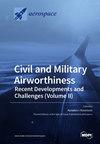Ice Object Exclusion Characteristics of Turboshaft Engine Inlet under Helicopter/Inlet Integration Conditions
IF 2.1
3区 工程技术
Q2 ENGINEERING, AEROSPACE
引用次数: 0
Abstract
In this study, the influence laws of different parameters on the exclusion characteristics of hailstone and ice flake, and on the aerodynamic performance of the inlet are studied by numerical method. The motion of the hailstone and ice flake is simulated using the 6-DOF method. Results show that the inhalation of hailstone in the inlet decreases total pressure distortion by about 20%, and the total pressure recovery coefficient is essentially unchanged. Icing of the upper lip decreases the total pressure distortion of the inlet by about 22%, and the total pressure recovery coefficient decreases by 0.6%. The ice flakes on the inner and outer lip, when shed and brake by collision with the center body, will cause damage to the engine duct. The shedding and breaking of ice flake at an angle of 150° to the lip can result in a large amount of ice flake debris entering the engine duct, threatening the performance and structure of the engine in the rear. The motion characteristics of hailstone and ice flake under helicopter fuselage/rotor/inlet integration conditions are revealed. It also provides a reference on the numerical methods for the numerical study of hailstone/ice flake exclusion characteristics of helicopter fuselage/rotor/inlet integration conditions.直升机/进气口一体化条件下涡轮轴发动机进气口的冰物排除特性
本研究采用数值方法研究了不同参数对冰雹和冰片排阻特性以及进气口气动性能的影响规律。采用 6-DOF 方法模拟了冰雹和冰片的运动。结果表明,冰雹吸入进气口会使总压畸变减少约 20%,总压恢复系数基本不变。上唇结冰会使进气口的总压力变形减少约 22%,总压力恢复系数降低 0.6%。内唇和外唇上的冰片在与中心机体碰撞脱落和制动时,会对发动机风道造成损坏。冰片的脱落和破碎与唇部成 150°角,会导致大量冰片碎片进入发动机风道,威胁后部发动机的性能和结构。揭示了直升机机身/旋翼/进气道一体化条件下冰雹和冰片的运动特性。同时也为直升机机身/旋翼/进气道一体化条件下冰雹/冰片排阻特性的数值研究方法提供了参考。
本文章由计算机程序翻译,如有差异,请以英文原文为准。
求助全文
约1分钟内获得全文
求助全文
来源期刊

Aerospace
ENGINEERING, AEROSPACE-
CiteScore
3.40
自引率
23.10%
发文量
661
审稿时长
6 weeks
期刊介绍:
Aerospace is a multidisciplinary science inviting submissions on, but not limited to, the following subject areas: aerodynamics computational fluid dynamics fluid-structure interaction flight mechanics plasmas research instrumentation test facilities environment material science structural analysis thermophysics and heat transfer thermal-structure interaction aeroacoustics optics electromagnetism and radar propulsion power generation and conversion fuels and propellants combustion multidisciplinary design optimization software engineering data analysis signal and image processing artificial intelligence aerospace vehicles'' operation, control and maintenance risk and reliability human factors human-automation interaction airline operations and management air traffic management airport design meteorology space exploration multi-physics interaction.
 求助内容:
求助内容: 应助结果提醒方式:
应助结果提醒方式:


